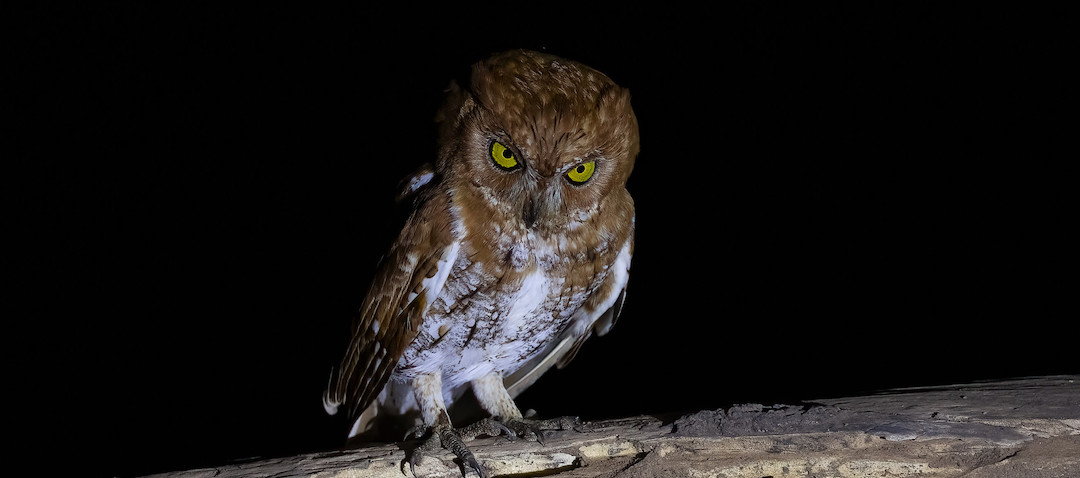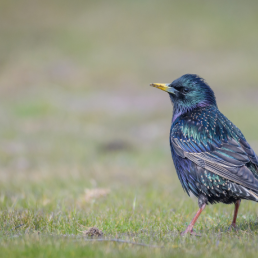

Join BirdNote tomorrow, November 30th!
Illustrator David Sibley and actor H. Jon Benjamin will face off in the bird illustration battle of the century during BirdNote's Year-end Celebration and Auction!

This Halloween, BirdNote is here to help you get acquainted with the eerie and mysterious side of birds! We’ve compiled a list of some of our spookiest BirdNote Daily episodes - shows about birds that go bump in the night. Check out these episodes that feature birds with scary reputations - like owls, vultures, and members of the corvid family - crows, ravens, jays and more!
- Who’s Afraid of Corvids? Of all the birds out there, the corvid family — the crows, ravens, and jays — might have the spookiest reputation. But this idea that corvids are spooky is far from universal — it's mainly in the Western world, as corvid researcher Kaeli Swift explains.
Want more? Check out "Spooky Birds that Squawk in the Dark" from Bring Birds Back! For Halloween, corvid researcher Kaeli Swift joins Tenijah for a show-and-tell of spooky birds. Corvids, vultures, and owls all have reputations as ominous and foreboding — and today, we’re digging into those ideas. Kaeli unpacks why the birds are seen as scary, shares cool facts beyond their mysterious façade, and explores conservation opportunities to help these birds.
- Crows Recognize Individual Faces: To find out if a crow can recognize an individual human face, Professor John Marzluff of the University of Washington wore a mask while trapping, banding, and then releasing seven American Crows on campus. Later, when he walked through the campus wearing the mask, it was automatic! A big group of birds scolded and divebombed him. He thinks it's a benefit to the birds' survival to point out and recognize challenges in their environment. Watch a video and learn more at ScienceMag.org.
- The Folklore of Owls: Thanks to Harry Potter, the owl is flying high. But throughout history, the owl has received mixed reviews. The Greeks believed an owl flying over a battlefield foretold victory, while in other cultures, owls were considered omens of death, prophets of doom. Listen to the story again, and you'll hear four different owls. The owls heard in this story, in order, are the Barred Owl, Barn Owl, Long-eared Owl, and Great Horned Owl.
- Ravens and Wolves: Researcher Bernd Heinrich writes: "Ravens associate with any animals that kill large game - polar bears, grizzlies, wolves, coyotes, killer whales, and humans." These birds travel with caribou on their migration, and scavenge remains after wolves have made their kills. The bill of the Common Raven can't cut into a carcass, so a large carnivore must tear through the tough hide first.
- The Vulture's Iron Stomach: Circling silently above the earth on broad, black wings, vultures need little introduction. We know them as nature's clean-up crew, dining on dead and decaying animals. A unique range of adaptations allows vultures such as this Black Vulture to feast on food that’s off limits for many other organisms. Vultures also appear to have a remarkable immune system. For them, and for many other organisms, one key to understanding their place in nature is understanding their relationship with other elements in their environment.
- Spark Bird: Kaeli Swift and the Rooftop Crows: When Dr. Kaeli Swift was in college, she became obsessed with the Corvid family of birds, which includes crows, ravens and jays. She decided to study whether crows learn to recognize certain human faces as friendly. She tried putting a mask on a mannequin holding peanuts, but the crows spotted the trick right away. Swift had to find a creative solution.
- Ravens and Crows - Who's Who? Is that big black bird a crow or a raven? How can you tell? Ravens (seen right here) often travel in pairs, while crows (left) are seen in larger groups. Also, study the tail as the bird flies overhead. A crow's tail is shaped like a fan, while the raven's tail appears wedge-shaped or triangular. Another clue is to listen closely to the birds' calls. Crows give a cawing sound, but ravens produce a lower croaking sound.
- The Royal Ravens: The Tower of London has a long and notorious history of murderous political intrigue, dungeons, and famous beheadings. And for more than 300 years, the tower has also been home to a set of royally maintained ravens. Since the time of Charles II, at least six ravens have - by royal decree - made their home in the tower. They are given ample food, comfy quarters, and private burials in the moat near Traitor's Gate.
- Shakespeare's Crows, Owls, and Ravens - With Rod Molzahn: Shakespeare's tragedies and histories are filled with crows, owls, and ravens, birds of evil portent, promising sickness and death. Shakespearean actor Rod Molzahn describes some of them! King Henry speaks to Gloucester: "The Owl shriek'd at thy birth - an evil sign; the Night-Crow cried, aboding luckless time, the Raven rook'd her on the chimney's top, and chattering Magpies in dismal discords sung." Lady MacBeth, contemplating the killing of King Duncan, observes, "The Raven himself is hoarse that croaks the fatal entrance of Duncan under my battlements." Bolingbroke describes midnight as, "Deep night, dark night, the silent of the night when Screech-Owls cry..."
- Spooky Shearwaters: Some early sailors, visiting remote Pacific islands, surely feared that the ungodly wailing on shore meant they had been tricked to the gates of Hell itself. In truth, they stood among courting pairs of seabirds called Wedge-tailed Shearwaters. These birds nest on islands in the tropical Pacific and Indian Oceans. During courtship, pairs perform long duets of eerie wailing.
Happy Halloween from BirdNote!
Oriental Scops Owl © Hari K Patibanda
